Neisseria polysaccharea
N. polysaccharea was described in 1983 and is characterized by its ability to produce acid from glucose and maltose and polysaccharide from sucrose. Strains of this species were previously identified as nontypable strains of N. meningitidis. Strains of N. polysaccharea also may have been misidentified previously as N. subflava because their ability to produce polysaccharide from sucrose was not determined.
Table 1. Characteristics of N. polysaccharea
| Characteristic | Illustration |
|---|---|
| Gram stain Cell Morphology | Gram-negative diplococcus |
| Colony Morphology |  |
| Pigmentation | 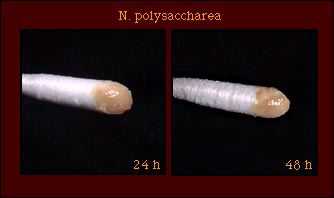 |
| Oxidase Test | 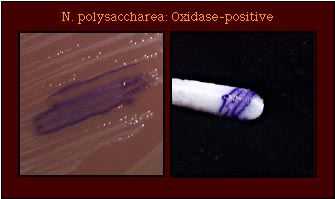 |
| Acid Production |  |
| Enzyme Substrate Test | Prolyl aminopeptidase +ve |
| Nitrate Reduction Test | Nitrate -ve |
| Polysaccharide from Sucrose | 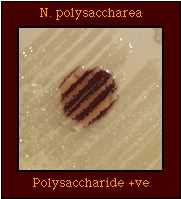 |
| Production of Deoxyribonuclease (DNase) |  |
| Superoxol Test (Reaction with 30% hydrogen peroxide) | 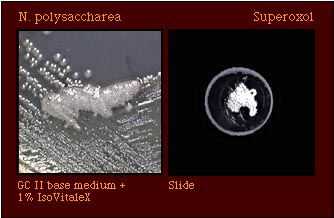 |
| Catalase Test | 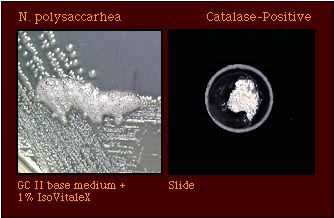 Catalase-positive |
| Colistin Resistance | 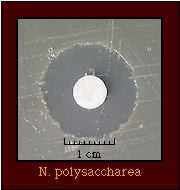 |
Neisseria species which may be misidentified as N. polysaccharea by acid production tests and supplemental tests that differentiate between them
Table 2. Differential characteristics of Neisseria spp. which produce acid from glucose and maltose and supplemental tests that differentiate between them.
| Species | Acid from | Poly- saccharide from Sucrose | Pigment | Enzyme Substrate Test | Colistin Resistance* | ||||
|---|---|---|---|---|---|---|---|---|---|
| G | M | S | F | L | |||||
| N. polysaccharea | + | + | - | - | - | + | - | PAP +ve | (R) |
| N. meningitidis | - | - | GGT +ve | R | |||||
| Lactose-negative N. lactamica* | + | + | - | - | - | + | + | ß-GAL +ve | R |
| N. sufblava Biovar subflava | + | + | - | - | - | - | + | GGT +ve or PAP +ve | (R) |
| N. subflava Biovar flava** | + | + | - | + | - | - | + | GGT +ve or PAP +ve | (R) |
Abbreviations: G, glucose; M, maltose, S, sucrose; F, fructose; L, lactose; PAP. Prolyl aminopeptidase; GGT,?(gamma)-glutamyltransferase; ß(beta)-GAL, ß(beta)-galactosidase, . +, most strains positive; -, most strains negative; (+), some strains give weak positive reactions which are not representative of the species; R, strains grow well on selective medium for N. gonorrhoeae and/or show no inhibition around a colistin disk (10 micrograms); (R), most strains susceptible, some strains resistant.
*The author has encountered one strain of lactose-negative N. lactamica; this strain was identified with an enzyme substrate test which demonstrated that the organism produced ß(beta)-galactosidase.
**N. subflava biovar flava will be identified as N. subflava biovar subflava if acid production from fructose is not determined.
Although enzyme substrate tests are intended to be used only for the identification of Neisseria spp. isolated on selective media for N. gonorrhoeae, isolates of N. polysaccharea may give the same reaction (PAP +ve) in this test as do isolates of N. gonorrhoeae. Thus additional tests must be performed to differentiate between these species.
Table 3. Supplemental tests which permit differentiation among Neisseria and related species that produce prolyl aminopeptidase in enzyme substrate tests
| Species that Produce PAP | Cellular Elongation* | Acid from | Nitrate Reduction | Polysaccharide from Sucrose | Superoxol | Colistin Resistance | ||||
|---|---|---|---|---|---|---|---|---|---|---|
| G | M | S | F | L | ||||||
| N. polysaccharea | Diplococci | + | + | - | - | - | - | + | Weak (1+) to strong (3+) positive | (R) |
| N. flavescens | Diplococci | - | - | - | - | - | - | + | Weak (2+) positive | S |
| N. cinerea | Diplococci | (-) | - | - | - | - | - | - | Weak (2+) positive | (R) |
| N. gonorrhoeae | Diplococci | + | - | - | - | - | - | - | Strong (4+) positive | R |
| N. gonorrhoeae subspecies kochii | Diplococci | (-) | - | - | - | - | - | - | Strong (4+) positive | R |
| K. denitrificans | Rod filaments | + | - | - | - | - | + | - | - | R |
| N. subflava biovar subflava | Diplococci | + | + | - | - | - | - | - | Weak (2+) positive | S |
| N. subflava biovar flava | Diplococci | + | + | - | + | - | - | - | Weak (2+) positive | S |
| N. subflava biovar perflava | Diplococci | + | + | + | + | - | - | + | Weak (2+) positive | (R) |
| N. sicca | Diplococci | + | + | + | + | - | - | + | Weak (2+) positive | S |
| N. mucosa | Diplococci | + | + | + | + | - | + | + | Weak (2+) positive | S |
| N. elongata | Rod filaments | - | - | - | - | - | - | - | - | S |
Abbreviations: G, glucose; M, maltose, S, sucrose; F, fructose; L, lactose; PAP. Prolyl aminopeptidase; GGT,γ(gamma)-glutamyltransferase; ß(beta)-GAL, ß(beta)-galactosidase. +, most strains positive; -, most strains negative; (+), some strains give weak positive reactions which are not representative of the species; R, strains grow well on selective medium for N. gonorrhoeae and/or show no inhibition around a colistin disk (10 micrograms); (R), most strains susceptible, some strains resistant.
References
Bouquette MT, Marcos C, Saez-Nieto JA. Characterization of Neisseria polysaccharea sp. nov. (Riou, 1983) in previously identified noncapsular strains of Neisseria meningitidis. J Clin Microbiol 1986;23:973-975.
Bøvre K. Family VIII. Neisseriaceae Prevot, In NR Krieg (ed.). Manual of Systematic Bacteriology, vol. 1. The Williams & Wilkins co., Baltimore. 1984. p 288-309.
Guibourdenche M, Popoff MY, Riou JY. Deoxyribonuclease acid relatedness among Neisseria gonorrhoeae, N. meningitidis, N. lactamica, N. cinerea, and "Neisseria polysaccharea." Ann Inst Pasteur Microbiol 1986;137B:177-185.
Knapp JS. Historical perspectives and identification of Neisseria and related species. Clin Microbiol Rev 1988;1:415-431.
Knapp JS, Rice RJ. Neisseria and Branhamella. In. Murray PR, Baron EJ, Pfaller MA, Tenover FC, Yolken RH. (ed.). Manual of Clinical Microbiology. 6th ed. American Society for Microbiology, Washington D. C, 1995.
Riou JY, Guibourdenche M. Neisseria polysaccharea sp. nov. Int J Syst Bacteriol 1987;37:163-165.
Riou JY, Guibourdenche M, Popoff MY. A new taxon in the genus Neisseria. Ann Microbiol (Paris) 1983;134B:257-267.
Vedros NA. Genus I. Neisseria Trevisan 1885, 105AL, In NR Krieg (ed.). Bergey's Manual of Systematic Bacteriology, vol. 1. The Williams & Wilkins Co., Baltimore. 1984. p 290-296.
- Page last reviewed: March 31, 2017
- Page last updated: October 17, 2008
- Content source:


 ShareCompartir
ShareCompartir